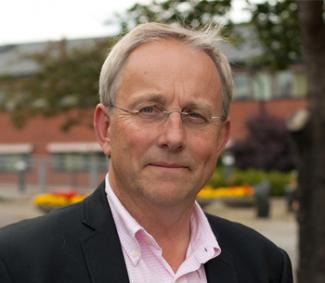Global UN conference on Road safety in Sweden: Fatal road accidents halved by year 2030
Over 1.3 million people die in traffic accidents every year. Consequently, traffic accidents are the most common cause of death in certain age groups. The world's experts are now gathering in Stockholm to discuss new UN goals for road safety, developed under the leadership of Chalmers professor Claes Tingvall.
Transports and traffic are fundamental parts of life for most of us. From our homes, we step into a traffic system that takes us to work, school, business, health care or to our loved ones. But at the same time, 1.3 million people are killed in road accidents and 50 million people are injured – every year. Most accidents, as much as 93 per cent, occur in low- and middle-income countries, where the resources and technical solutions for road safety are lacking to a larger extent.
“The problem of road accidents has not diminished the way we hoped. The recommendations proposed by our expert group are effective actions – it is now a matter if it gets done or not”, says Claes Tingvall, adjunct professor at the Department of Mechanics and Maritime Sciences at Chalmers and chair of the academic expert group that has developed new UN targets for world road safety.
The overall goal is to reduce the number of deaths and serious injuries as a result of traffic accidents by fifty per cent over the next ten years. To achieve this goal by the year 2030, Claes Tingvall is certain about the way forward:
“We must constantly point to science as the solution to societal problems. Then stick to it and act accordingly!”
A public health issue
On February 19–20, 2020, the world's leading road safety experts will convene together with decision-makers and ministers in Stockholm for the third global conference on road safety within the UN. There, the expert group's opinion will be indicative for the global cooperation for safer traffic.
The academic expert group, chaired by Claes Tingvall, is composed of 13 experts from around the world and has been tasked with developing complementary methods, processes and tools for the new decade's global traffic safety. The fundament has been the global goals for sustainable development and Agenda 2030.
“The lack of road safety is a public health issue. More than 100,000 children die each year in traffic accidents, making it the most common cause of death for in certain age groups. But it is possible to solve the problem, provided that scientifically developed methods are used”, says Claes Tingvall.
Collaboration is the key
Today broad research is being conducted in vehicle and road safety at Chalmers. The focus is, among other things, on understanding why accidents occur and how they can be prevented, as well as minimizing injuries to the human body when it is exposed to the extreme stresses that often occur in traffic accidents. Historically, vehicle and traffic safety has been a strong research area at Chalmers and the development of modern seat belts, child safety seats and airbags originated at the university.
Research within road safety will be even more significant in the future as the volume of traffic is constantly increasing. According to the UN, the world's cities will grow by over 50 per cent in the next 30 years. It is important to have knowledge of how to develop roads and infrastructures in the best possible way as it is being built, while scientific solutions are applied and developed in already existing traffic systems.
Magnus Granström is the director of the SAFER Vehicle and Traffic Safety Centre at Chalmers, where multidisciplinary research is conducted in road safety. At SAFER, various research areas – such as systems for accident prevention, road user behaviour, human body protection and safety performance evaluations – connect. Magnus Granström believes that there are many sub-areas to focus on in road safety, and unprotected road users will be a special challenge as we see an increasing number of cyclists, electric scooters and pedestrians.
“Universities need to continue to invest in a breadth of research, as there is no single answer to the question of how traffic should continue to become safer. Above all, understanding the complexity of future traffic systems with different types of road users will be necessary”, says Magnus Granström.
To reach the goal of cutting the number of deaths and injuries by half, Magnus Granström believes that the research community needs to gain further insight into existing obstacles. For example, he points to an over-reliance in automated vehicles and their contribution to increased safety, as well as a lack of system thinking among researchers and financiers, who instead focus too much on individual areas and personas.
“The main key to achieving this goal is collaboration between the various players – industry, academia and politics”, says Magnus Granström.
Recommendations with a clear vision
The academic group of experts has presented a total of nine scientifically based recommendations. If the recommendations are followed, the expert group believes that the goal of reducing the number of deaths by half is likely to be achieved by 2030. The recommendations are interconnected and will guide the work on road safety as part of the Global Sustainable Development Goals. And for the first time, road safety is now included in international objectives through agenda 2030.
“With the global goals, which point out who should do what, we have access to both the private and the public sector, and thus can benefit from the synergies that exist between climate, health and justice. For example, speed connects to clean air, climate and security”, says Claes Tingvall.
At the same time, he emphasizes the fact that the most powerful tools will also make the greatest impact. Those tools are mainly about sustainability reporting and public procurement. If the work on road safety is integrated with these tools, large effects can be achieved. The report that the expert group recently released highlights collaborations between politics, academia, business and other organizations on a global scale.
“To solve the problems in low-income countries, where the problems are greatest, you need to apply the simple and cheap solutions that already exist. In high-income countries, all known methods must be applied – it's as simple as that.
Pre-event organised by SAFER
On the evening of February 18, the day before the UN conference, SAFER organizes a pre-event in Stockholm. The focus will be to share knowledge on how to successfully collaborate on traffic safety. About 200 guests are expected, including EU commissioners, decision-makers, Swedish parliament politicians and organisations working with traffic safety from all over the world. Most of the guests come from countries with many fatal road accidents, including Uganda, Liberia, India and Nigeria.
“We hope to spread the message about our way of collaborating to the international actors participating it our event, and at the same time create even better communication between both partners and research areas”, says Magnus Granström.
FACTS: Nine recommendations for safer traffic
The expert group's recommendations is divided into:
1. Modal Shift
2. Sustainable Practices and Reporting
3. Safe Vehicles across the Globe
4. Childrens Health
5. Public Procurement
6. Speed limit of 30 kph
7. Upgrade Infrastructure
8. Zero Speeding
9. Technology
Read the complete recommendation document in the link below.
FACTS: The Sustainable Development Goals
The Sustainable Development Goals were adopted by all United Nations Member States in 2015 as a universal call to action to end poverty, protect the planet and ensure that all people enjoy peace and prosperity by 2030.
Road safety is directly connected to two of the 17 global goals:
Goal 3: Good health and well-being
Target 3.6: Halve the number of global deaths and injuries from road traffic accidents.
Goal 11: Sustainable cities and communities
Target 11.2: Provide access to safe, affordable, accessible and sustainable transport systems for all, improving road safety, notably by expanding public transport, with special attention to the needs of those in vulnerable situations, women, children, persons with disabilities and older persons.
Road safety also affects many of the other global goals indirectly.
Read more about the UN Sustainable Development Goals here: https://sustainabledevelopment.un.org/sdgs
Text: Anders Ryttarson Törneholm and Mia Malmstedt
Photos: Rune Borgström, Emmy Jonsson and Pixabay



